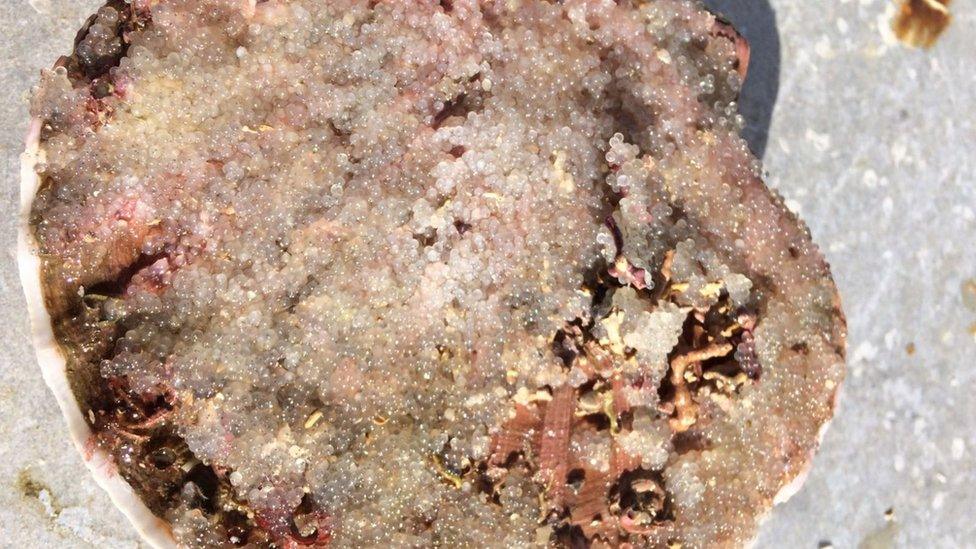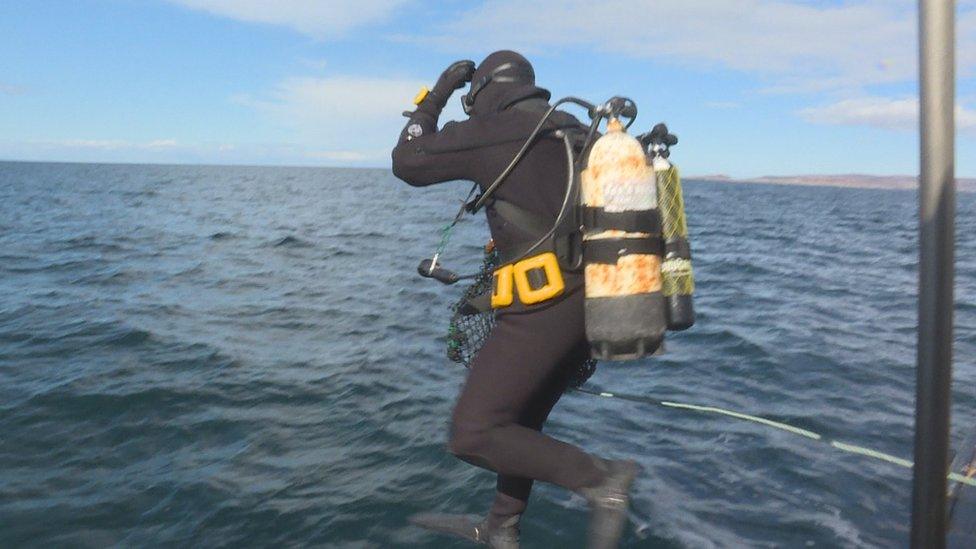Huge herring spawning ground discovered in Wester Ross
- Published
- comments

The divers found the eggs (darker sections) covering the sheltered ridges of the seabed
A huge spawning ground for herring has been discovered near Gairloch in Wester Ross.
The ground, thought to be around three square kilometres, was discovered by scallop divers who operate in the area.
Scientists from Marine Scotland are examining egg samples from the site to try to identify their genetics.
It is hoped the find is a positive step towards the restoration of herring stocks which were wiped out by overfishing in the 1960s and 70s.
The site is south west of Gairloch village at a point where the Inner Sound meets the Minch.
It straddles a marine area which is closed to dredging boats and there are now calls for that protection to be extended across the whole spawning ground.

The eggs were discovered by scallop divers
The concern is that gear dragged along the sea bed would damage the eggs when they are at their most vulnerable.
Diver Alex Cameron was one of the first to discover the site.
He told BBC Scotland News: "It's just as if there's been a hail storm through it and there is loads of hail on the sea bed floor, obviously with the hail being the herring eggs. The whole place is absolutely covered.
"It was pretty amazing, yeah. I have never come across anything like that."
Efforts have been under way for several years to "rediscover" wild herring around Gairloch.
A local project was aiming to document the history of the industry which dominated north west coastal communities for centuries.
But the Wester Ross Fisheries Trust, which was behind the project, now hopes the new discovery could elevate herring out of the history books.

Sue Pomeroy from the trust said: "I'm surprised and excited because herring stocks have fallen since the 1970s. The odd herring in spawn had been found but nothing this size.
"Both Ullapool and Gairloch were founded on the herring industry - it was the keystone subsistence for the people who lived here. Then in the 1920s to the 1950s the fishermen were raking it in, absolutely raking it in. Families and the whole community relied very heavily on the herring industry.
"Basically, they went out and fished and fished and fished and caught more and more and more."
It takes about 10 days for the eggs to hatch in water temperatures experienced in the Minch.
The process appears to have already begun with signs that egg numbers are diminishing.
There are other spawning grounds off Scotland with a large one near Cape Wrath on the north coast.
But that one is for Autumn Herring which spawns later in the year.
'Fantastic opportunity'
Local skipper Alasdair Hughson said: "It's a fantastic thing to have found. Not only have we proved now that this area is for certain a herring spawning ground. We've also seen … how important the sea bed is.
"It would be a fantastic opportunity for the future if, and I do say if, there are signs of a recovery here. It's just hard to describe how important it could be for the future of fisheries in an area like this.
"Gairloch probably wouldn't be here if it wasn't for the herring, like many other ports along the west, north and east coast of Scotland."
Overfishing has long been considered the main reason herring numbers fell sharply.
But more recent research suggests climate change affecting plankton, which the young herring need to survive, could also have played a part.
A Scottish government spokeswoman said: "This report of large concentrations of herring spawn off Gairloch is welcome news.
"The area where eggs have been found recently was first identified as being important for herring spawning nearly 100 years ago, and herring populations off the west coast have fluctuated significantly over the intervening period.
"Marine Scotland has been working with the fishing industry to try and understand the factors at play. We encourage the different sectors of the fishing industry to continue working together to help improve the stock."
She added: "In addition, there are wider management measures in place to protect the marine environment in this area, including a year round fisheries closure to mobile bottom-contacting fishing gears in Loch Gairloch, and protection for harbour porpoise."